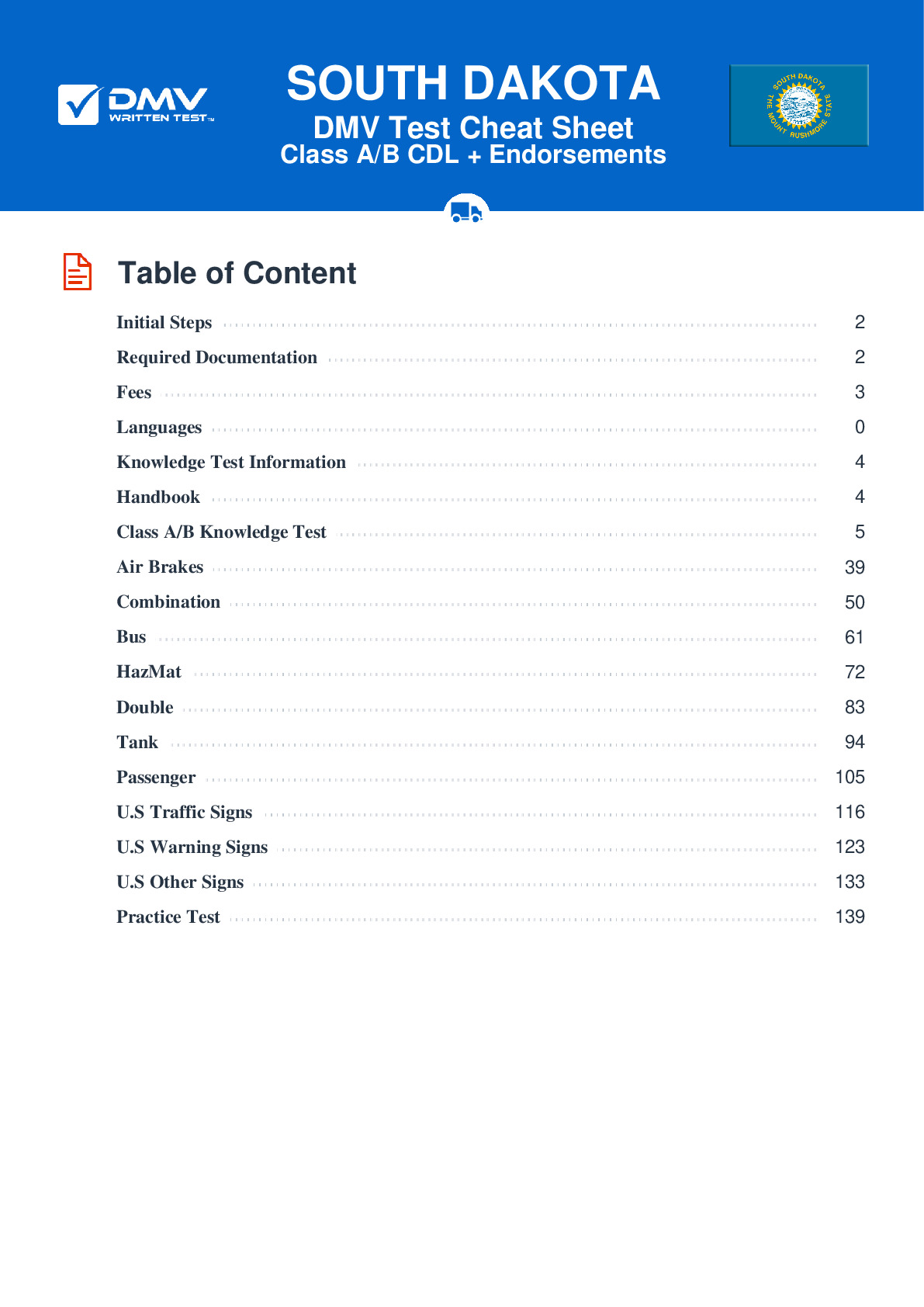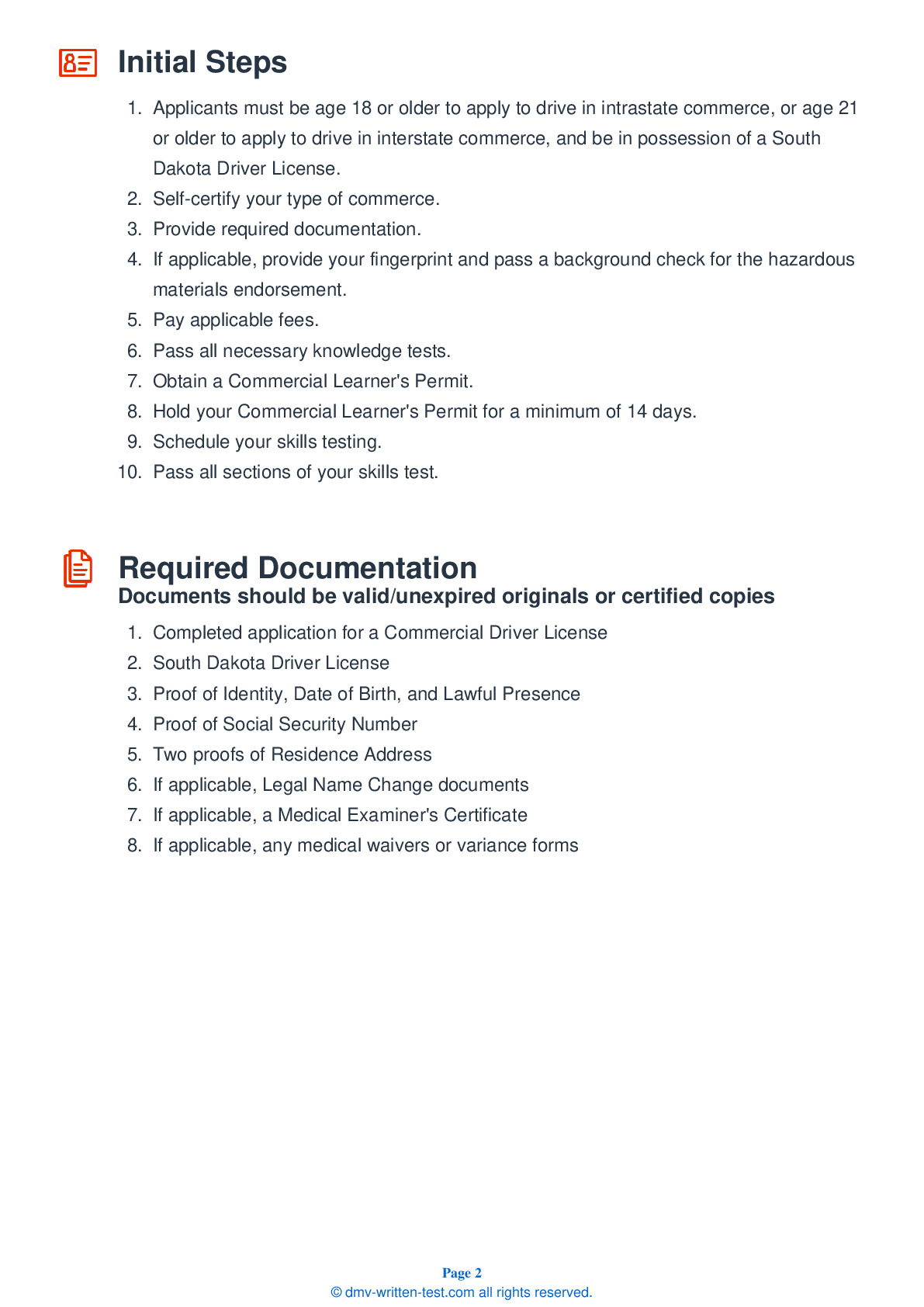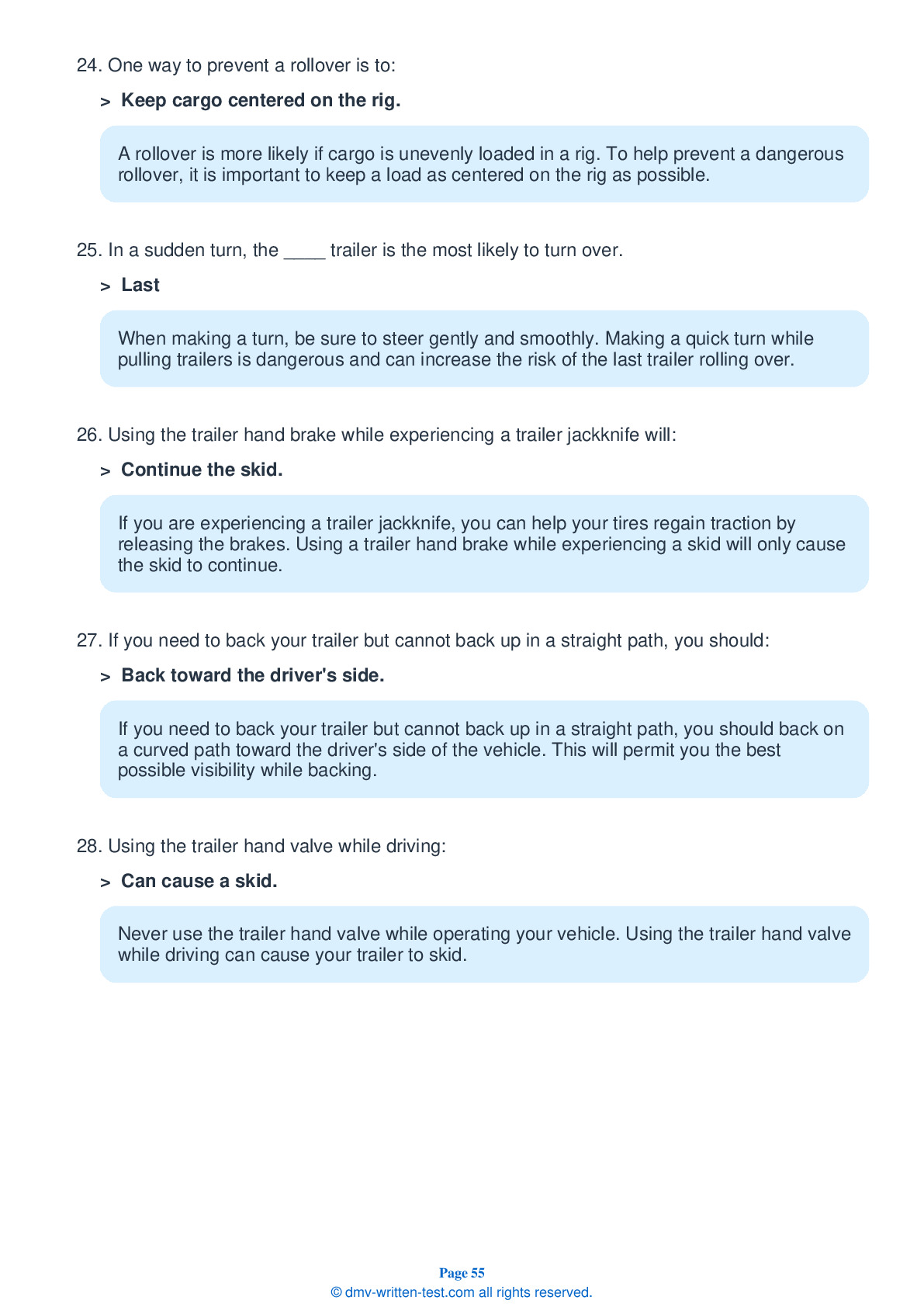Knowledge Test Class A
This license is required for driving any legal combination of vehicles, with a gross combination weight rating of 26,001 pounds or more, provided the GVWR of a trailer exceeds 10,000 pounds To receive this license, applicants must pass a 50-question test. To pass, applicants must answer 40 questions correctly. Each question has three or four possible answer choices. Test questions come from the South Dakota Commercial Driver License Manual. Questions come from chapters covering: Introduction, Driving Safely, Transporting Cargo Safely, Air Brakes (if applicable), Combination, Doubles and Hazardous Materials. Endorsements that may be used with a Class A CDL are: Hazardous materials, Tank, Passenger, HazMat and Tank, Air Brakes and School bus.
36. An example of required emergency equipment is:
All commercial motor vehicles are required to be equipped with the proper emergency equipment. This may include spare electrical fuses; three red reflective triangles, six fuses, or three liquid burning flares; and at least one properly charged and rated fire extinguisher.
37. In a leaf spring:
When inspecting your vehicle's suspension, verify that leaf springs do not have missing or broken leaves. If at least one-fourth of the leaves in a leaf spring are missing, the vehicle will be put out-of-service until the defect is fixed.
38. While driving, if you notice anything that affects safety or could lead to mechanical problems, you should:
After finishing a day of driving, you may have to complete a written report on the condition of your vehicle. Be sure to mention anything that could affect safety or lead to mechanical breakdown.
39. What should you do if your vehicle gets stuck on railroad tracks?
If your CMV gets stuck on railroad tracks, you should immediately leave the vehicle and get away from the tracks. Check the signposts or signal housing at the crossing for emergency contact information and call 911, or another appropriate emergency number.
40. When traveling with cargo, you must make sure the cargo is secure:
Cargo should be inspected before beginning a trip, within the first 50 miles of the trip, and every three hours or 150 miles traveled. The driver of a truck transporting cargo is responsible for the cargo being safely secured throughout the trip.
41. Most heavy-duty vehicles use ____ air brake systems.
The majority of heavy-duty vehicles are equipped with dual air brake systems.
42. When you must travel down a hill, when should you switch into a lower gear?
You should always slow down and shift into a lower gear before starting down a hill. If you do not begin to drive down a hill at a low enough speed, you risk overusing your brakes, causing them to overheat and fade.
Frequently Asked Questions
Here are the steps to obtain a Class A CDL license in South Dakota:
1. Obtain a South Dakota Commercial Learner's Permit (CLP) by passing the written knowledge test for the Class A license.
2. Hold your CLP for at least 14 days before taking the skills test.
3. Schedule and pass a skills test consisting of three parts: pre-trip inspection, basic vehicle control, and on-road driving. The skills test must be taken in a vehicle that matches the class of CDL you are applying for.
4. Submit your application for a Class A CDL license to the South Dakota Department of Public Safety. You will need to provide proof of identity, residency, and citizenship or lawful presence in the United States.
5. Pay the required fees for your CDL license.
6. Obtain any necessary endorsements for your CDL license, such as hazardous materials or passenger endorsements.
Remember that obtaining a CDL requires a lot of responsibility and safety is always paramount when operating commercial vehicles on public roads.
1. Tractor-trailer combinations
2. Truck and trailer combinations
3. Livestock carriers
4. Tanker vehicles
5. Flatbeds
6. Dump trucks
7. Double and triple trailers
It's important to note that with a Class A CDL license, you are also authorized to operate any vehicle that falls under Class B and Class C categories. However, you may need to obtain additional endorsements based on the type of cargo you intend to carry or the passengers you will transport. These endorsements include hazardous materials, passenger transport, and tank vehicle endorsements.
1. You must be at least 18 years of age to operate a commercial vehicle within the state of South Dakota. However, if you plan to drive interstate, you must be at least 21 years old.
2. You must have a valid South Dakota driver's license.
3. You must pass a vision test and meet the minimum vision requirements.
4. You must obtain a South Dakota Commercial Learner's Permit (CLP) by passing the written knowledge test for the Class A license.
5. You must hold your CLP for at least 14 days before taking the skills test.
6. You must pass a skills test consisting of three parts: pre-trip inspection, basic vehicle control, and on-road driving. The skills test must be taken in a vehicle that matches the class of CDL you are applying for.
7. You must provide proof of identity, residency, and citizenship or lawful presence in the United States when submitting your application for a Class A CDL license to the South Dakota Department of Public Safety.
8. You must pay the required fees for your CDL license.
Remember that obtaining a CDL requires significant responsibility, and safety is always paramount when operating commercial vehicles on public roads.
1. Hazmat Endorsement (H): Required for drivers who will be transporting hazardous materials.
2. Tanker Endorsement (N): Required for drivers operating vehicles that carry liquid or gaseous materials in bulk containers with a capacity of 1,000 gallons or more.
3. Double/Triple Trailer Endorsement (T): Required for drivers who will be operating vehicles with two or three trailers attached.
4. Passenger Endorsement (P): Required for drivers who will be operating vehicles designed to transport 16 or more passengers, including the driver.
5. School Bus Endorsement (S): Required for drivers who will be operating school buses designed to transport passengers.
To obtain these endorsements, you must pass additional knowledge tests and, in some cases, skills tests related to the specific type of endorsement you are seeking. Additionally, some endorsements may also require a background check and fingerprinting. It's important to note that endorsement requirements vary by state and by employer, so it's always a good idea to check with your state's Department of Public Safety and/or your employer before applying for a job that requires a CDL endorsement.
1. Pre-Trip Inspection: You will be required to complete a pre-trip inspection of your vehicle to ensure that it is safe and roadworthy. During the inspection, you will be asked to identify and explain the function of various parts and components of the vehicle.
2. Basic Vehicle Control: You will be required to demonstrate your ability to control the vehicle in various situations, including backing up, turning, and parking. You will also be asked to perform a straight line backing maneuver and a 90-degree alley dock backing maneuver.
3. On-Road Driving: You will be required to demonstrate your ability to safely operate the vehicle on public roads. You will be evaluated on your ability to follow traffic laws, maintain proper lane position, use turn signals and mirrors correctly, and adjust your driving based on road conditions.
During the skills test, you will be evaluated by a certified examiner who will score you based on your performance in each part of the test. To pass the skills test, you must receive a passing score in each section of the test. It's important to note that the skills test requirements may vary by state, so it's always a good idea to check with your state's Department of Public Safety for specific information on their CDL skills test requirements.
1. Air Brakes Restriction: If you take your skills test in a vehicle without air brakes, you will receive an “L” restriction on your license, which means you are not authorized to operate vehicles with air brakes.
2. Automatic Transmission Restriction: If you take your skills test in a vehicle with an automatic transmission, you will receive an “E” restriction on your license, which means you are not authorized to operate vehicles with a manual transmission.
3. Intrastate Only Restriction: If you only plan to operate commercial vehicles within your state, you may receive an “O” restriction on your license, which means you are not authorized to operate commercial vehicles across state lines.
4. Medical Certification Restriction: You may receive a “V” restriction on your license if you do not meet the medical certification requirements for driving a commercial vehicle.
It's important to note that restrictions may vary by state and by employer, so it's always a good idea to check with your state's Department of Public Safety and/or your employer for specific information on any restrictions that may apply to your Class A CDL license.
However, if you have difficulty with English language proficiency, you may request an interpreter to assist you during the exam. The interpreter must be fluent in both English and the language requested by the applicant. The interpreter may not provide answers or coaching during the exam but can only assist with translating exam questions and answers.
It's important to note that South Dakota requires all CDL applicants to have a good command of the English language, as it is the universal language used in the transportation industry. The ability to understand and communicate in English is essential for safe driving and effective communication with law enforcement, other drivers, and dispatchers.
To request accommodations, you will need to submit a Request for Accommodation form to the South Dakota Department of Public Safety. The form should be accompanied by documentation of your disability and a description of the accommodation(s) needed. The department will review your request and determine what accommodations are appropriate based on your disability and the requirements of the CDL exam.
Examples of accommodations that may be provided include extended testing time, a private testing room, assistive technology, or a reader or sign language interpreter.
It's important to note that requests for accommodations must be made in advance of the exam date, and that the department may require additional information or documentation before approving an accommodation request. If you have any questions about requesting accommodations for the Class A CDL written test, you should contact the South Dakota Department of Public Safety's Driver Licensing Program.
It is important to note that if you fail the test three times, you will be required to wait at least 14 days before taking the test again. If you fail the test six times, you will be required to wait at least 30 days before taking it again.
It's a good idea to study and prepare thoroughly before retaking the test. You may want to review the CDL manual and take practice tests to identify areas where you need more study and practice. Additionally, consider seeking assistance from a CDL training school or professional tutor if you continue to struggle with passing the exam.
Remember that passing the written test is just one step in obtaining your CDL license. You will also need to pass a skills and driving test in order to obtain your license.




